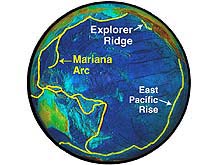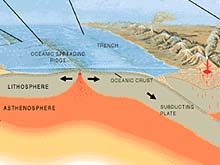
A global view of the Pacific Ring of Fire, showing the mid-ocean ridge and island arc/trench systems.Click image for larger view.
Submarine Ring of Fire 2004 - Mariana Arc
March 27 - April 18, 2004
The 2004 Submarine Ring of Fire exploration was a follow-up to last year’s trip along the Mariana Arc volcanic chain. The 2003 expedition surveyed more than 50 submarine volcanoes and discovered that 10 of them had active hydrothermal systems (See "Explorations of Mariana Arc Volcanoes Reveal New Hydrothermal Systems" (pdf, 890 Kb)).
This year, the team planned to make a series of dives
to visit some of these hot-spring sites along the Mariana Arc. Visit the ![]() Mariana
Arc virtual fly-throughs and panoramas of eight individual sites.
Mariana
Arc virtual fly-throughs and panoramas of eight individual sites.
They used a remotely operated vehicle (ROV) called ROPOS, which allowed them to explore and collect samples from the hydrothermal sites.

Most submarine volcanoes occur where tectonic plates are either moving apart or colliding. Click image for larger view.
Updates & Logs
The Ring of Fire Missions
Click images or links below for more information on all Ring of Fire missions.
 April 15, 2004 Scientist discover that fish are the dominant consumer organism at Kasuga-2 and Daikoku submarine volcanoes.
April 15, 2004 Scientist discover that fish are the dominant consumer organism at Kasuga-2 and Daikoku submarine volcanoes.
 April 14, 2004 Presence of plankton at vent sites vary. Follow along with the scientists as they discuss the location and type of plankton samples.
April 14, 2004 Presence of plankton at vent sites vary. Follow along with the scientists as they discuss the location and type of plankton samples.
 April 13, 2004 How does the team determine how much hydrothermal fluid percolates through each volcano? Find out.
April 13, 2004 How does the team determine how much hydrothermal fluid percolates through each volcano? Find out. April 12, 2004 The team describes the two basic types of microbial mats found at the NW Eifuku Volcano.
April 12, 2004 The team describes the two basic types of microbial mats found at the NW Eifuku Volcano.  April 11, 2004 Biologists discover an extraordinary community of hydrothermal mussels.
April 11, 2004 Biologists discover an extraordinary community of hydrothermal mussels.  April 10, 2004 Scientists discover a hydrothermal site venting "champagne" droplets over a mile beneath the surface.
April 10, 2004 Scientists discover a hydrothermal site venting "champagne" droplets over a mile beneath the surface.  April 9, 2004 The team returns to Maug Island to find the source of hydrothermal venting that was detected last year.
April 9, 2004 The team returns to Maug Island to find the source of hydrothermal venting that was detected last year.  April 8, 2004 Ecothoughts: Identifying Vent Ecosystems on the Fly. Learn how ecologists prepare for a cruise where most of the biological communities to be explored are unknown.
April 8, 2004 Ecothoughts: Identifying Vent Ecosystems on the Fly. Learn how ecologists prepare for a cruise where most of the biological communities to be explored are unknown. April 6, 2004 See the chemical reaction of the hydrothermal fluids (250°C, 480°F) as they mix with the seawater (7°C, 45°F) to form thick clouds of metal-rich smoke, hence the oft-referred name of “black smokers”.
April 6, 2004 See the chemical reaction of the hydrothermal fluids (250°C, 480°F) as they mix with the seawater (7°C, 45°F) to form thick clouds of metal-rich smoke, hence the oft-referred name of “black smokers”.  April 5, 2004 Explore the East Diamante volcano by viewing the imagery from “Barnacle Beach”, the "5 Towers", and the beauty of the "Aquarium" sea life.
April 5, 2004 Explore the East Diamante volcano by viewing the imagery from “Barnacle Beach”, the "5 Towers", and the beauty of the "Aquarium" sea life.  April 4, 2004 Geoloists perform an autopsy on the West Rota volcano, attempting to reconstruct its violent past.
April 4, 2004 Geoloists perform an autopsy on the West Rota volcano, attempting to reconstruct its violent past. April 2, 2004 Scientists take a closer look at the living creatures that survive on these underwater volcanos.
April 2, 2004 Scientists take a closer look at the living creatures that survive on these underwater volcanos.
 April 1, 2004 The team visits Brimstone pit with shimmering water percolating at a temperature over 100ºC!
April 1, 2004 The team visits Brimstone pit with shimmering water percolating at a temperature over 100ºC!  March 30, 2004 Read about the amazing scene of white smoke billowing out of a 60-foot crater. The scientific team discover one of the hottest spots yet found on any submarine volcano.
March 30, 2004 Read about the amazing scene of white smoke billowing out of a 60-foot crater. The scientific team discover one of the hottest spots yet found on any submarine volcano.The Ring of Fire Missions
Click images or links below for more information on all Ring of Fire missions.

Take a trip to the seafloor! Explore the hydrothermal vents of the Magic Mountain Chimney Fields via a series of interactive computer animations and videos. (Where is Magic Mountain?)
 Submarine Ring of Fire 2007
Submarine Ring of Fire 2007(July - August) Scientists return to the Kermadec Arc, to explore in great detail the Brothers submarine volcano. This will mark the most comprehensive exploration of this type of arc volcano and is one of the most vigorous geothermaly active yet discovered.

(April - May) Scientists return to explore active submarine volcanoes lying along the Mariana Arc, extending for more than 800 nautical miles.

(April - May) Join scientist as they explore the active submarine volcanoes along the Kermadec Arc, located north of New Zealand, with a pair of manned submersibles the PISCES IV and V.

(March - April) An interdisciplinary team of scientists returned to the submarine volcanoes of the Mariana Arc to explore, utilizing an underwater tethered robot (ROPOS).

(February - March) An interdisciplinary team of scientists explored the submarine volcanoes of the Mariana Arc lying north of Guam in the western Pacific.

(June - August) An interdisciplinary exploration team used new technology to investigate the birth of new ocean crust off the coast of western North America, part of the Pacific "Ring of Fire."



























